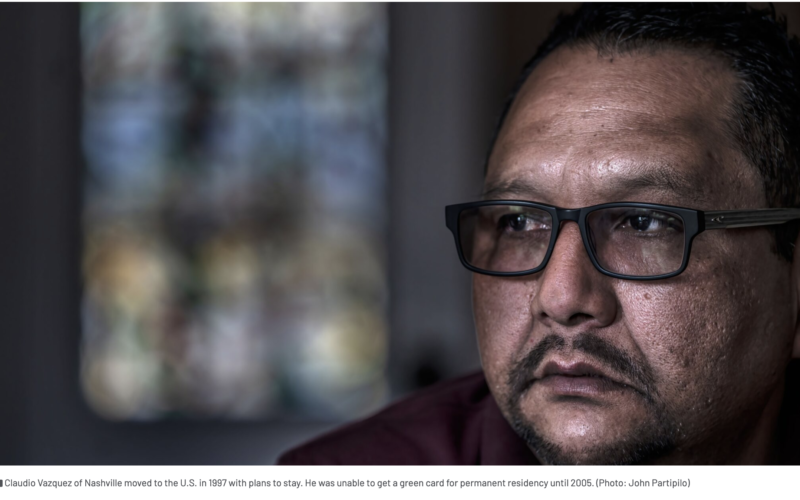Biden administration proposes increases visas to combat U.S. labor shortages
by Dulce Torres Guzman
Claudio Vazquez came to the U.S. on a tourist visa in 1997 and planned to stay permanently.
Noting the differences between the U.S. and Mexico, Vazquez was shocked to learn how easily people could buy basic commodities in the States, such as a used car.
“In Mexico, I would have to work a year to afford a down payment and then see if I am able to make monthly payments even if the car was used,” he said.
Even eating meat was a luxury.
“When people ask me what the difference is, when I want to eat shrimp, I eat that day instead of having to wait two weeks to see if I have enough money left over to eat shrimp,” he said.
“It sounds ridiculous but it’s the simple things,” he added.
As his tourist visa expired, Vazquez found himself living in the U.S. under undocumented status and sought to legalize his position. He applied for residency under 245(i), which allows those with unlawful immigration status to apply for permanent residency under certain conditions. At the time, applicants needed to be sponsored by an employer or family, pay a $1,000 fee, and to have filed a petition by April 30, 2001.
The deadline was extended, given that the U.S. Immigration and Naturalization Service was slow to draft rules for the process, according to the CQ Press Library.
So Vazquez, having had a background in radio, applied for 245(i) in December 2000 as a radio show employee, arguing that there was a need for more Spanish-speaking media. Then, he waited.
Several years passed.
On Sept. 11, 2001, Congress was set to pass an extension on 245(i) through April 30, 2002. Terrorist attacks that day held up the passage and the extension never passed.
For nearly a decade, Vazquez lived in fear while waiting for his application to be processed. He always drove carefully, never once driving over the speed limit. He only had one mishap when police mistakenly believed he was driving a stolen car that he had recently purchased. He was eventually let go after a reprimand.
At one point he contemplated leaving the U.S., but finally, his worker permit arrived in 2004, then a green card in 2005. Another seven years would pass before Vazquez was able to become an American citizen and he visited Mexico for the first time in a decade.
“It’s a different kind of freedom,” he said.
But while things worked out for him, Vazquez has numerous friends still living in the shadows of society and knows options are very limited for them even if they seek to work.
“I have a lot of friends who are always worried and I want them to have peace of mind,” he said.
The Great Resignation
As the pandemic entered its second year, employers noticed a shift in the workforce. Instead of having a readily available stream of potential employees, applications dried up as people feared catching COVID-19 at their workplace, transitioned to remote work or quit due to health concerns for themselves and immunocompromised family members.
In 2021, more than 47 million workers quit their jobs, according to the U.S. Chamber of Commerce, and as of Feb.2022, there were 10.9 million open jobs in the U.S., but only 6.5 million unemployed workers.
The industries most affected are traditionally low-paying jobs that don’t allow for virtual work, such as transportation, healthcare and food sectors.
While those industries are experiencing a labor shortage, high-paying industries allowing employees to continue working from home have a surplus, according to the study conducted.
And still other Americans have chosen to remain unemployed, either retiring early or relying on federal programs such as unemployment benefits, stimulus payments and the Child Tax Credit program.
Workers are seeking a better balance between life and work, increased compensation and strong company culture, and because of this, in-person jobs, which traditionally provide lower wages, have had a difficult time retaining workers, concludes the study.
But the U.S. government has a solution: increase the number of legal immigrants.
I have a lot of friends who are always worried and I want them to have peace of mind. It’s a different kind of freedom.
Worker Visas to Combat Labor Shortages
As a solution to worker shortages, the Biden administration is seeking to add more immigrant workers to the U.S. labor force.
On Jan. 28, 2022, the U.S. Citizenship and Immigration Services increased the number of H-2B visas by 20,000, and currently moving through Congress is the Healthcare Workforce Resilience Act, which aims at recapturing unused visas in an effort to combat shortages among healthcare workers.
In the healthcare and social assistance industry,more than 200,000 immigrants worked as doctors and medical students during the pandemic despite their status as recipients of DACA, or Deferred Action for Childhood Arrivals, according to the Center for American Progress.
And according to the American Immigration Council, immigrants make up a significant portion of the U.S. workforce in key areas, accounting for two-fifths of all farming, fishing and forestry workers, and one-quarter of computer and math science specialists.
Still, these efforts focus on bringing in immigrants from outside the country and little effort to allow undocumented residents living in the U.S. to work legally.
A Restricted Immigration System
For those already living in the U.S., few options are available for those seeking to become American citizens.
According to the U.S. Citizenship and Immigration Services, most eligibility options for green cards are reserved for those entering the country under certain circumstances, such as sponsorship through close relatives who are U.S. citizens, including parents and spouses, a plan to invest at least $1 million in commercial enterprise in the U.S. or having worked with U.S. military forces.
For those already living in the U.S. options are even more limited.
While marrying a U.S. citizen is still an option, other immigrants have received legal status as victims of a crime, after suffering domestic violence, human trafficking or being willing to testify against criminal activity. Those escaping violence in their home countries can apply for asylum status. And for those who have resided in the U.S. since childhood, the DACA program allows them to temporarily work legally. Efforts to make this program permanent, called the Dream Act, have failed in Congress so far.
A Qualified, but undocumented academic
Nearly a decade ago, “M” made a decision he deeply regretted.
At a coffee shop surrounded by vibrant boutiques and tourists, “M” contemplated how much the outside world reflected the dreams he had once had upon arriving in the U.S.
About 15 years ago, “M” left South Africa after seeing increasing bouts of violent crime. He paused for a moment while seated at a coffee shop, gesturing at the people chatting casually outside the window.
“You cannot do this in South Africa. You would be robbed in broad daylight,” he said.
With South Africa’s high unemployment rates, “M” decided to attend Vanderbilt University on a student visa, eventually graduating with a masters degree in economics. He hoped to pursue a career and eventually start a family in the U.S. Upon graduating, “M” looked into becoming a permanent resident. Instead, “M” found that the process was much more complicated.
While it was possible for students with an F-1 visa to transition to green cards, or permanent residence, applicants have few choices. Before their visas expire, applicants can find a job in their field of specialty by having an employer pay to sponsor them, according to Visaguide.world.. Applicants can also self-petition as a person with extraordinary abilities in their field of study,, which requires paying high fees and does not guarantee a green card.
“M” chose to self-petition but quickly encountered hurdles as lawyers promised legalization at $14,000. In other words, he could become an American citizen, but only if he had money.
His choices dwindled. In facing a decision of leaving more than a decade of work behind if he were forced to return to South Africa, “M”, who asked to remain anonymous for fear of repercussions, made a fateful decision.
“M” looks like any other American citizen. He speaks clear English with only a slight hint of an accent, and carries himself with the air of a scholar. But years of hiding among the far corners of society have worn him down. Since he has chosen to stay in the U.S., he has lived in Tennessee as an undocumented resident, unable to apply for a driver’s license and barely making ends meet.
“It was a bad, bad decision,” he said.
With bills to pay, “M” manages to make some income tutoring high school students and working side gigs, although his options are limited.
He was recently asked to work in an adult literacy program at a local church, but because they asked for paperwork, he has been unable to respond.
For years, “M” has struggled, But recently, he revealed his undocumented status to those around him, because he was tired of struggling.
“I might have to pack up and go home but I’ve been fighting for so long to live here,” he said.
Immigration in the Past
Since before the Civil War, the South has largely depended on cheap labor, and when slavery became illegal, the federal government sought other ways to supplement the labor force.
Between 1942 and 1964, an agreement between Mexico and the U.S. allowed millions of Mexican men to work under short-term labor contracts, otherwise known as the Bracero Program.
Abuses were rampant. Although employers were required to provide housing, living conditions were often substandard, and workers were victims of wage thefts.
Still, many Mexican men were able to procure citizenship through sponsorship by employers and therefore bring their families to join them in the U.S. Many subsequent generations of Latinos can trace their heritage back to the Bracero Program.
In 1986, President Ronald Reagan signed an immigration reform bill into law, allowing any immigrant who had entered the country before 1982 to be eligible for amnesty. His focus was on undocumented immigrants who had worked as farm laborers.
Today, Metro Nashville Councilmember Sandra Sepulveda, the first Latina to be elected to Metro Council, traces her roots back to Reagan’s policies, when her parents were given legal status due to their work as agricultural workers.
“From my research, I saw documentation of great-grandparents coming and working the field, so I have that history, but other than that my parents came as teenagers. They worked in the fields, picking flowers for some time,” she said.
Anti-immigration policies today and abuse
“One thing we can count on, when it comes to our state legislators, to only be anti-immigrant when it comes to certain groups of people,” said Sepulveda, responding to a bill currently making its way through the state Legislature.
Sponsored by Rep. Bruce Griffey, R-Henry, HB1636 seeks to lower the current requirement for employers to use the E-Verify program from 50 employees to 25 in order to prevent businesses from knowingly employing undocumented people.
Yuri Cunza, president of the Nashville Area Hispanic Chamber of Commerce, calls the bill “politically convenient that has no impact,” since both employers and and undocumented employees have long learned how to circumnavigate the system.
“There’s a whole network of people that sell you identities for about $1,000,” he said, adding that the bill caters to conservative constituents’ unfounded fears of undocumented immigrants taking jobs no one wants to take anyway.
Instead, their focus should be on combating the labor shortages the U.S. is currently facing, either by expanding the current worker programs or allowing those already here to legally work, he said.
“There’s an opportunity to be resourceful here,” he added. Yuri Cunza, president of the Nashville Area Hispanic Chamber of Commerce, calls a bill by Rep. Bruce Griffey, R-Paris,“politically convenient that has no impact,” since both employers and and undocumented employees have long learned how to circumnavigate the system. Griffey’s bill would lower the requirement for employers to use E-Verify from 50 employees to 25.
The H-2 programs, H-2A and H-2B, allow immigrants the ability to work here legally as agricultural workers and non-agricultural workers under the notion that there are not enough American citizens willing to work in these fields, according to USCIS.
Under this notion, labor shortages become a bipartisan problem, especially if there are no American workers willing to take positions.
“We should avoid a system that rewards illegal immigration,” said Raul Lopez, founder of the conservative organization Latinos for Tennessee.
“But if we cannot find American workers to meet current labor shortages, then yes, we should support legislation that would expand workers visas for health care and other industries in need,” he added.
Demand for H-2 visas exceeded the current caps since before the pandemic, but due to labor shortages, requests for H-2B visas hit a near record of 136,555, according to the Department of Labor.
With the Biden administration increasing the amount of worker visas, employers are tempted to see immigrants as the magic bullet to labor shortages as a scenario where everyone wins.
The reality is substantially worse, said Caitlin Berberich, an attorney at Southern Migrant Legal Services.
Just as the original H-2 programs, otherwise known as the Bracero Program, was riddled with abuses, so are their modern-day counterparts.
Because the visas are completely dependent on employers, immigrant workers arriving in the U.S. are at the mercy of their employers and may face substandard living conditions, poor wages and few legal protections.
H-2A visas are also directly tied to the employer, leaving workers unable to transfer to a better job in the same field.
Agricultural employers have also been known to threaten H-2A holders with deportation, and since some have taken great expenses to come to the U.S. in search of a better life, they are unable to protect themselves.
“From the employer’s perspective, ‘I get a totally captive labor force that is economically desperate for employment,’” said Berberich.
And while the Bracero Program allowed workers to become citizens, H-2 programs are more limited and often rely on employer sponsorship. Employers may be tempted to see immigrants as a silver bullet to labor shortages but in reality, the H-2 visa program lends itself to abuse of immigrant workers dependent on their employers, says an attorney with Southern Migrant Legal Services.
“It’s hard to envision how the system would not be exploitative unless the government was doing a lot more oversight,” she added.
The Right to Work
Although Vazquez knows there’s some people that take advantage of the immigration system, the vast majority come to the U.S. seeking a new life, work, and the ability to chase the American dream sold to them as children.
Vazquez became a citizen in 2012, married, had a son and currently works as an independent contractor for Banderita and earns good commissions. He plans on living and dying in the U.S. so his son can visit, and considers Nashville to be his home.
He recognizes that others have not had the same opportunities as him. When President Barack Obama visited Nashville, Obama allowed Univision news reporter Jorge Ramos to interview him at Casa Azafrán. Vazquez believed immigration reform would soon follow. Instead, the Dream Act failed in the U.S. Senate.
“We just want to work and become a part of society. Nashville has treated me well, and I am very grateful to everyone here,” said Vazquez.
“M” expressed the same sentiments. He has made friends in Nashville, and has lost friends due to his undocumented status.
“People have accepted me, they love me and I love them,” he said.
While some days are more difficult than others, “M” is hopeful he will someday be able to use his degree in the U.S. to work and live in the U.S.
“It’s not a great life, but it’s a life. I’m free at least,” he said.
This work is licensed under a Creative Commons Attribution-NoDerivatives 4.0 International License.





